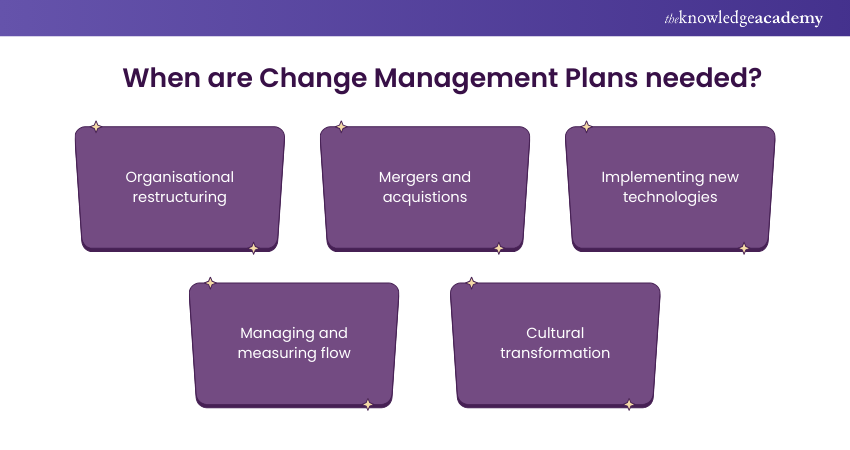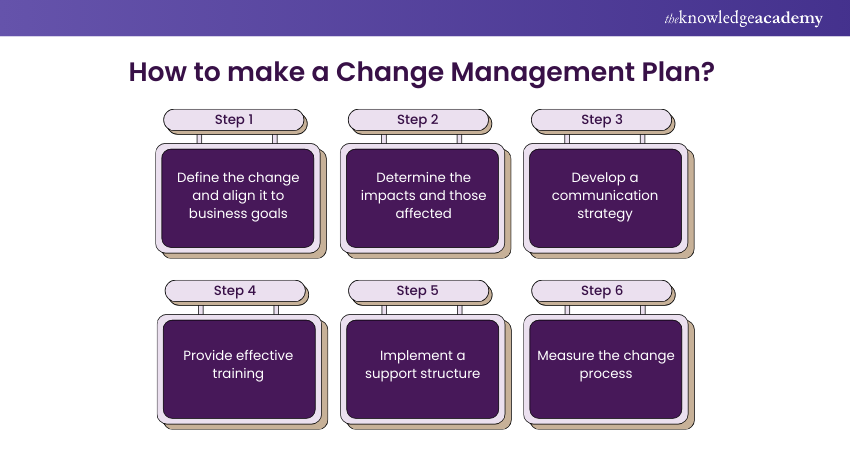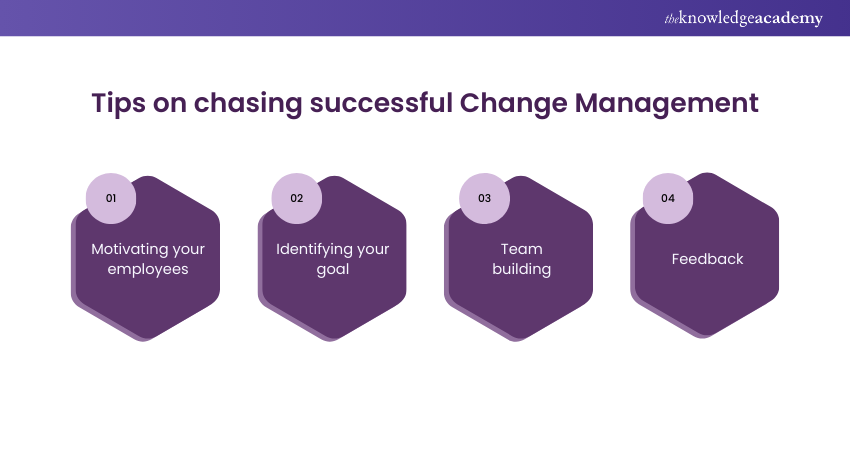We may not have the course you’re looking for. If you enquire or give us a call on 01344203999 and speak to our training experts, we may still be able to help with your training requirements.
We ensure quality, budget-alignment, and timely delivery by our expert instructors.

Businesses must evolve in today’s dynamic market, embracing new tech and strategies. Change is constant, necessitating ongoing adaptation. A Change Management Plan ensures smooth transitions, minimising resistance. An effective change management strategy guides firms to a prosperous future state.
A 2022 Statista report shows that 28% of organisations actively embrace Change Management. This underscores modern businesses' need to develop strategies to handle ongoing changes. This blog will explore a Change Management Plan, how to assess the need for change, and the process of formulating such a plan.
Table of Contents
1) What is a Change Management Plan?
2) When are Change Management Plans needed?
3) Elements of a Change Management Plan
4) How to make a Change Management Plan?
5) Change Management Plan templates
6) Importance of Change Management
7) Change Mangement processes
8) Tips on chasing successful Change Management
9) Conclusion
What is a Change Management Plan?
A Change Management Plan comprises the crucial aspects for organisations to abide by while embarking on their transformative journey. The plan is a structured approach that outlines the processes, strategies, and actions necessary to manage and implement change effectively within an organisation, often drawing from various change management models. Additionally, it provides a roadmap for guiding individuals and teams through the transition from the current state to the desired future state.
The plan encompasses various elements, such as:
1) Defining clear objectives
2) Building a Change Management team
3) Developing a communication plan
4) Identifying and managing stakeholders
5) Creating an implementation strategy
6) Providing training and support
7) Evaluating the change's success

When are Change Management Plans needed?
Change management plans are needed whenever an organisation faces transitions that can disrupt established routines, challenge the status quo, or require individuals and teams to alter their behaviours, methodologies, or ways of thinking, as outlined in the Effective Change Management Best Practices Guide. Here are some specific instances when Change Management Plans are especially beneficial:

1) Organisational restructuring: If a company decides to restructure its operations, whether by merging departments, downsizing, or adopting a new organisational design, it will significantly affect employees. A Change Management Plan can help ensure a smoother transition.
2) Mergers and acquisitions: Combining two organisations with distinct cultures, systems, and processes can be challenging. Change Management can assist in integrating the two entities more seamlessly.
3) Implementing new technologies: Introducing new software, tools, or hardware requires employees to adapt to new working methods. Change Management tools ensure that the transition is smooth and employees are adequately trained.
4) Shift in strategy or business model: If a company decides to pivot or alter its business model, it must ensure all stakeholders understand, buy into, and are aligned with the new direction.
5) Cultural transformation: If an organisation is looking to change its corporate culture – for example, to become more innovative or customer-centric – this requires a shift in behaviours, mindsets, and values.
Upgrade your Change Management skills today with our Change Management Practitioner Course.
Elements of a Change Management Plan
To understand a Change Management Plan successfully, you must understand its elements. These are as follows:

a) Change Management roles: There are separate designated roles responsible for any changes in the plan. They are also responsible for reviewing any changes in the plan.
b) Stakeholder analysis: The changes in the plan the members bring should consider the people directly affected by the changes. It involves considering the impacts of any changes made during the development process.
c) Changing control board: This board is responsible for approving any of the changes that are being made or sending them back to improve on.
d) Change request form: To improve or make any changes, you need to create a change request form through which all the applications for changes will come in. It creates a systematic process, which helps in maintaining all the information.
e) Change log: To know about the progress made, you need to check all the tracks of the changes that have been made or are in process. This change log helps to locate if changes have been made.
Ready to lead and drive success? Enroll in our Change Management Certification program to gain the skills and credentials you need.
How to make a Change Management Plan?
To bring or make changes to any plan, you must make a Change Management Plan first. This plan creates a baseline that measures the time, cost, and scope of the project. Its necessary to align your initiatives with the change management principles which will help in judging the quality of the project. These few steps will help you understand how to make it:

Important steps to consider before creating Change Management Plan
Before crafting a Change Management Plan, it’s essential to consider several key steps to ensure its effectiveness:
Step 1. Define the change and align it to business goals:
When making any changes to a business, it’s crucial to consider several key factors. Firstly, ensure that the change aligns with the organisation’s objectives. Additionally, evaluating whether the change is ethically sound, strategically sensible, and financially feasible is important.
Step 2. Determine the impacts and those affected:
Before you make any major decision for the organisation to change your ideas, you should be mindful and calculate the impact and the number of people the change will affect.
Step 3. Develop a communication strategy:
There should be a common communication channel where you can convey all your ideas to your team members and vice versa. Instead of opting for multiple channels, deciding on one common form helps to manage and keep a record of all the key messages.
Discover the Impact of Change Management Salaries on Career Growth and Organizational Success!
Step 4. Provide effective training:
There might be a chance that the new changes and ideas might make your team members or employees uncomfortable. They might not be able to comprehend the changes. Hence, to combat that, you can opt for a common training channel where you can deliver an understanding of new tools and techniques.
Step 5. Implement a support structure:
Helping your employees or team members when they are adapting to these changes is your main responsibility. You should have a common support system in place so that employees can access this structure anytime they face an issue.
Step 6. Measure the change process:
While you are in the process of implementing changes for your business, you should also measure the progress that is being made. This measurement helps you understand the impact and necessity of the change on your business.
Unlock your organisation's potential with our Change Management Foundation Course - embrace change, drive success!
Change Management Plan templates
If you are not using any tool for your planned Change Management, then you can utilise certain tools that help you achieve your goals. There are several templates for this purpose. They are:
Change proposal template
This template is necessary when you need to draft a proposal first to apply your changes. It also helps the company understand why you are asking for these changes and the estimated cost and effort that is going to be invested in this proposal. This is how you draft a Change proposal template:
|
[Organisation’s name] Purpose of Change: [Brief description of the purpose] Reason [Brief description of the reason for change] Probable outcomes [Make a list of possible outcomes] Time taken [A brief estimate of time is going to take] Probable cost [ A brief estimate of the cost that may be incurred] Additional factors [ A brief list of the factors which may bring about a change in the process] |
Get ready for your interview with our top Change Management Interview Questions.
Change Leaders template
To carry out any change in your organisation, you need to appoint some leaders who will take care and look after the whole situation. To identify or select your leaders, you can follow this template:
|
[Organisation’s name] Change Leader 1: [Name] [Title] [Role] [Reason for selection] [Major responsibilities] [Names of team members under Change Leader 1] Change Leader 2: [Name] [Title] [Role] [Reason for selection] [Major responsibilities] [Names of team members under Change Leader 2] |
Get Paid What You Deserve! Find out the latest change manager salary data. Learn More!
Communications strategy template
As mentioned before, team members need to feel comfortable with the changes made. For all their solutions, an effective communication channel must be maintained. You can do this in the form of this template:
|
[Organisation’s name] Change Management model: [Briefly describe what the changes you have implemented in this model] Change Leader: [Name] [Title] [Role] Event: [When is the change due for] [Initial training] [Date of starting execution] [Process executed] Date: [Date of the event] Parties involved: [Number of people involved] Need for communication: [Brief description of why this communication is necessary] Channel of communication: [Briefly describe how, when and who will be involved in this communication] |
Discover the Best Change Management Books! Read our top picks and transform your organization today!
Tools template
Some tools and models help you bring change to the organisation. With proper tools, it is easier for you to make the intended changes. You can use this template to show how these tools can be used:
|
[Organisation’s name] Change Management model: [A brief description of the tool or model used for your process] Tool 1: [Name of the tool used] [Purpose of the tool] [Name of the Change Leader] [Tool used by] [Cost of the tools] Tool 2: [Name of the tool used] [Purpose of the tool] [Name of the Change Leader] [Tool used by] [Cost of the tools] |
Training template
Suppose you need to train employees or team members for a successful Change Management Plan. For this, you can follow the template to track the progress:
|
[Organisation’s name] Change Management model [A brief description of the model] Type of training: [A brief description of the type of training that will be implemented] Attendees: [ Names of employees who will be attending the training session] Possible outcome: [Brief description of training goals] Time taken for training [A probable time that will be taken for the training period] Cost of the training [Brief estimate of the training will cost] |
Change Management Analysis template
For a Change Management Plan to take place, there are several steps that have to be taken. It is important that you analyse each of these steps to stay on track of the progress made. Here's a sample template for Change Management Analysis:
|
[Organisation’s name] Change Management model: [A brief description of the model] Event: [A brief description of the events aligned] Date: [Date of the event] Date of analysis: [Mention the date when the analysis will be taken] Issues: [A brief description of the mistakes or errors made] Successes: [A brief description of the positive outcome] Action required: [A brief description of the conclusion and the actions that are yet to be taken] |
Do you want to improve your job prospects in Change Management? Then register now for our Certified Professional Change Management (CPCM) Course!
Importance of Change Management
Change Management is pivotal for organisations to:
a) Lessen resistance and foster support for change through strategic communication and concern resolution.
b) Align changes with the company’s strategic aims and objectives, ensuring they reflect the organisation’s vision.
c) Improve the success of change initiatives by implementing them more effectively.
d) Minimise operational disruptions and employee impact, making transitions smoother and more efficient.
e) Boost communication and teamwork during change, aligning all stakeholders with a shared objective.
f) Sustain changes by ingraining new practices within the organisational culture.
g) Enhance success rates by proactively managing potential issues before they escalate.
Learn how you can manage change with Agile Methodology – register now with our Managing Change with Agile Methodology Training!
Change Management processes
The Change Management process paves the way for successful Change Management. These enable the submission, tracking, scheduling, and management of change requests from inception to completion. A comprehensive change management system provides a centralised repository for all change-related data, standardises procedures, facilitates trend analysis, and grants access anytime, anywhere.
A proficient system should offer capabilities such as:
a) Task decomposition
b) Customisable change request templates
c) Financial planning and cost management
d) A change history log
e) Role-based assignments
f) Tailorable change management workflows
g) A calendar for planned changes
h) Categorisation flexibility between changes and defects
i) Reassignment options across individuals, teams, or Change Boards
j) Change updates and oversight
k) Monitoring of change implementation
l) Approval workflows for changes
Ready to achieve mastery in Change Management? Level up with our Change Management Black Belt course.
Tips on chasing successful Change Management
Here are some of the tips which will help you in chasing successful Change Management:

a) Motivating your employees: It is common for your employees to lose motivation while adapting to these changes. Keeping goals that can be achieved easily helps them stay motivated.
b) Identifying your goal: The best way you can achieve your goals is to identify them first. Identifying your goals helps you to form the correct strategies for your team.
c) Team building: No matter the nature of the changes or the goals for your business, it is imperative that you maintain companionship between team members. This companionship helps you drastically increase the progress of your process.
d) Feedback: Acting on feedback will help you and your team to bring about all the changes in the organisation. This will also help you to identify the weaknesses and strengthen your team. By working on these weaknesses, it is possible to avoid any errors in the future.
Dive into the detailed Case Study on Change Management
Conclusion
Creating a comprehensive Change Management Plan is crucial for organisations seeking successful change implementation. Organisations can navigate the complexities of change and achieve their desired outcomes by understanding and adhering to the key aspects of the communication plan. Change is a constant in today's dynamic business world, and with a well-structured plan in place, organisations can embrace change as an opportunity for growth and long-term success.
Learn about the various principals and aims of Risk Management with our Risk Management for Change Training.
Frequently Asked Questions
What is included in a Change Management Plan?

A Change Management Plan typically includes the following:
a) Roles and responsibilities for managing change.
b) Processes for submitting and approving changes.
c) Communication strategies to inform stakeholders.
d) Training plans for employees.
e) Budgeting for change-related costs.
f) Monitoring tools to track progress and impact.
What is the purpose of a change plan?

The purpose of a change plan is to:
a) Minimise disruptions during transitions.
b) Ensure adoption and integration of changes.
c) Facilitate communication and manage resistance.
d) Provide a structured approach to implementing changes.
e) Support employees through the change journey.
What are the other resources and offers provided by The Knowledge Academy?

The Knowledge Academy takes global learning to new heights, offering over 3,000 online courses across 490+ locations in 190+ countries. This expansive reach ensures accessibility and convenience for learners worldwide.
Alongside our diverse Online Course Catalogue, encompassing 19 major categories, we go the extra mile by providing a plethora of free educational Online Resources like News updates, Blogs, videos, webinars, and interview questions. Tailoring learning experiences further, professionals can maximise value with customisable Course Bundles of TKA.
What is Knowledge Pass, and how does it work?

The Knowledge Academy’s Knowledge Pass, a prepaid voucher, adds another layer of flexibility, allowing course bookings over a 12-month period. Join us on a journey where education knows no bounds.
What are related Change Management Courses and blogs provided by The Knowledge Academy?

The Knowledge Academy offers various Change Management Certifications, including Change Management Foundation, Change Management Practitioner and Change Management Green Belt. These courses cater to different skill levels, providing comprehensive insights into Change Management Best Practices.
Our Project Management Blogs cover a range of topics related to Change Management Certification, offering valuable resources, best practices, and industry insights. Whether you are a beginner or looking to advance your Project Management skills, The Knowledge Academy's diverse courses and informative blogs have you covered.
Upcoming Project Management Resources Batches & Dates
Date
 Change Management Foundation & Practitioner
Change Management Foundation & Practitioner
Mon 31st Mar 2025
Mon 7th Apr 2025
Sat 19th Apr 2025, Sun 20th Apr 2025
Mon 28th Apr 2025
Mon 12th May 2025
Sat 17th May 2025, Sun 18th May 2025
Mon 19th May 2025
Mon 9th Jun 2025
Sat 21st Jun 2025, Sun 22nd Jun 2025
Mon 23rd Jun 2025
Mon 7th Jul 2025
Sat 19th Jul 2025, Sun 20th Jul 2025
Mon 21st Jul 2025
Mon 4th Aug 2025
Sat 16th Aug 2025, Sun 17th Aug 2025
Mon 18th Aug 2025
Mon 1st Sep 2025
Mon 15th Sep 2025
Sat 20th Sep 2025, Sun 21st Sep 2025
Mon 29th Sep 2025
Mon 13th Oct 2025
Sat 18th Oct 2025, Sun 19th Oct 2025
Mon 20th Oct 2025
Mon 27th Oct 2025
Mon 3rd Nov 2025
Mon 10th Nov 2025
Mon 17th Nov 2025
Sat 22nd Nov 2025, Sun 23rd Nov 2025
Mon 24th Nov 2025
Mon 1st Dec 2025
Mon 8th Dec 2025
Mon 15th Dec 2025
Sat 20th Dec 2025, Sun 21st Dec 2025






 Top Rated Course
Top Rated Course


 If you wish to make any changes to your course, please
If you wish to make any changes to your course, please


